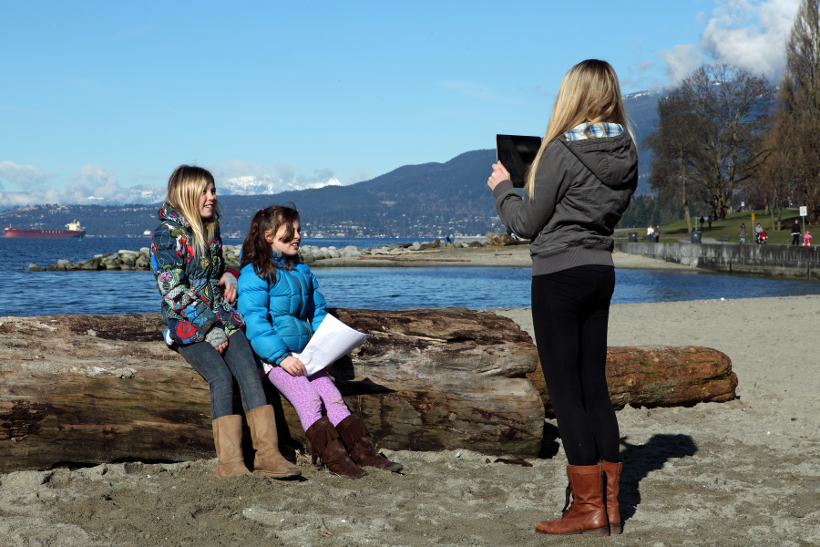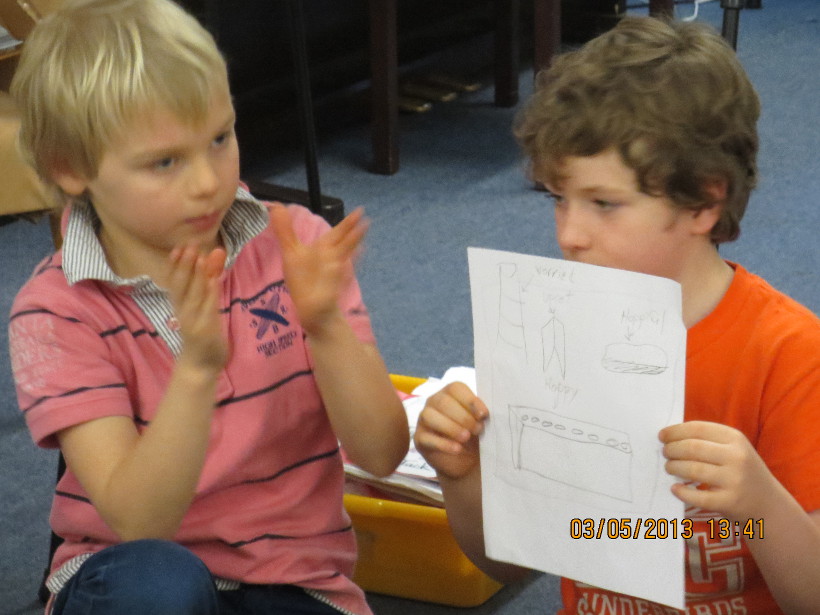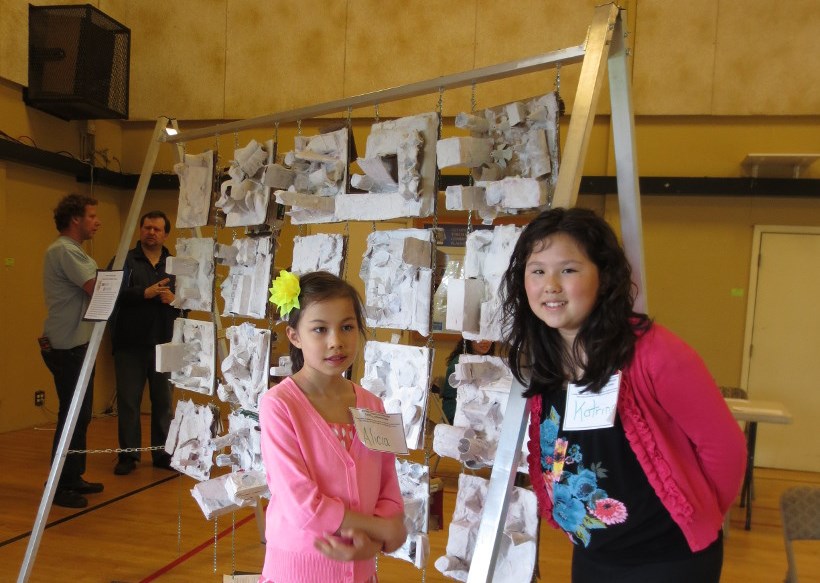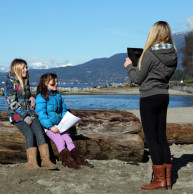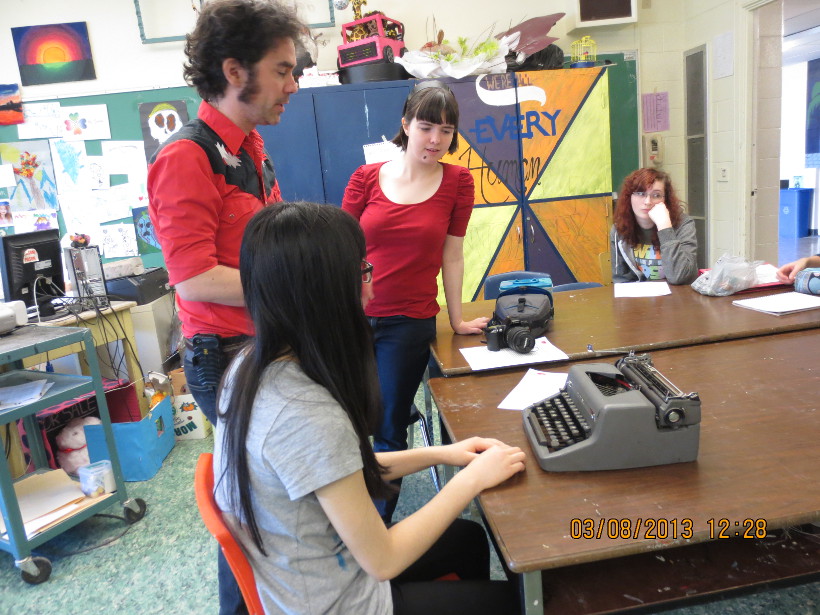Lions Bay Gr 3, Gleneagles Gr 5/6 and Rockridge Gr 10
Arts Education, Language Arts
Schools:
Gleneagles Elementary School, West Vancouver, BC
Lions Bay Community School, West Vancouver, BC
Rockridge Secondary School, West Vancouver, BC
Teachers:
Gleneagles Elementary School: Andrea Crowdis
Lions Bay Community School: Jody Billingsley/Candace Ross
Rockridge Secondary School: Laura Fitzpatrick/Carrie Berg
Artist:
Amelia Epp
Class:
Grade 3, Grade 5/6 and Grade 10
Sources of Inspiration:
Vancouver Biennale Legacy: 217.5 Arc x 13
Sculptures by Louise Nevelson and Isamu Noguchi
Overview:
This inquiry explores the idea of transitions involving three classes that are within the Horseshoe Bay geographical area and at some point all students feed into one of these schools. They represent different age groups that will and have faced the fears about changing from school to school. The students came together to visit the Biennale Legacy 217.5 Arc x 13 and shared their hopes and worries about changes. The 13 arcs were presented as representing the 13 years from Kindergarten to Grade 12. Facilitated by a visual artist and their teachers, the students explored ways to transform paper with their hands to create diverse shapes and textures. As a group and in partners they discussed words that reflect their hopes and worries about transitioning to another school. Students then matched emotions words to shapes and textures found in their classmates’ artwork. The students then captured their emotions through creation of 3D paper art to form a large scale sculpture of three metal swings. This sculpture is an abstract representation of the students’ collective voice and was shared with the broader community at three public exhibitions together with photo images of the visit to the Arc and digital recording of artist statements to describe this collaborative learning process.
BIG IDEAS:
Transitions: Changes through Time
Guiding Question:
How do our fears about change shape our beliefs about the unknown?
Curriculum Access:
Visual Arts (3D exploration and design, composition, abstract/visual metaphors), English Language Arts (brainstorming words, writing words), Social and Emotional Intelligence
Learning Process:
The repeated 13 resting curves of 217.5 Arc x 13 gives the piece a rhythmic feel that suggests movement and inspires the students to reflect upon their emotions as they face changes when move through school. Through this inquiry on transition, the students begin to accept their own fears are natural feelings and occur across age groups. The students from the three schools gathered during the initial field trip to the Arc and as ambassadors at the public exhibitions. Through sharing each other’s personal stories about changes in their lives, the students learnt to accept their own anxiety about transitions. Through teacher and artist facilitation, the students were guided to express these emotions through a visual art creation process.
More information: BC Art Teachers’ Journal, Volume 56, Number 1, 2014
Student Creations:
Lions Bay Community School Grade 3
-Students created an assemblage made up of pieces of paper that they transformed (twisting, tearing, folding, bending, etc.)
-Students created drawings and took photographs while on the field trip to 217.5 Arc x 13
-Students wrote interview questions to ask the 2 other classes of students, and then filmed each other conducting these interviews while on the field trip to 217.5 Arc x 13
-Students drew maps of the area surrounding their school depicting textures, geographical features, and other observations of their surroundings, and linking these observations to emotions
-Students created a 2-sided sculpture using recycled materials (cardboard). One side of the sculpture was covered by thin white paper. The shapes and textures on the sculptures represented the students hopes and fears about their upcoming transition to Gleneagles (or another school).
-Students wrote reflections on the process they underwent to create their final sculptures (Why did we do this project? How did we do this project? Describe the shapes and textures in your sculpture and what they mean.). Small groups of students were then recorded, as they discussed their reflections on the process.
Gleneagles Elementary School Grade 5/6
-Students created drawings and took photographs while on the field trip to 217.5 Arc x 13
-Students wrote interview questions to ask the 2 other classes of students, and then filmed each other conducting these interviews while on the field trip to 217.5 Arc x 13
-Students created an assemblage made up of pieces of paper that they transformed (twisting, tearing, folding, bending, etc.)
-Students created sketches in Horseshoe Bay textures, geographical features, and other observations of their surroundings, and linking these observations to emotions
-Students created rubbings of textures that they found in the area surrounding their school. They associated emotion words with these textures
-Students created casts of textured objects found in their classroom using plasticine
-Students created lists of emotion words that they associated with transitioning to another school. They then created planning drawings for reliefs that would represent these emotion words through shape/texture. They created birds-eye and cross-sectional drawings.
-Students created paper reliefs by: creating reliefs out of cardboard, found/recycled objects, and plasticine; covering these reliefs with plastic; applying layers of paper pulp to their reliefs; and carefully lifting the dried paper pulp reliefs from the base reliefs.
Rockridge Secondary School
-Students created casts of found objects using wet paper
-Students created abstract ceramic reliefs representing hopes and fears relating to transition. Students worked with a partner to join their 2 reliefs together.
-Students created cut paper sculptures representing transformation/transition
-Students worked in small groups to create a total of 13 swings out of plaster. Each swing represented a year of schooling, K-12.
-Students collaboratively assembled completed swings to create a single installation work
Taking Action:
The project offered the older students a leadership/mentorship opportunity to work with younger ones. By relaying their experiences, they can ease the worries the younger students face in the change of school. Through the creative process, the secondary students reflected on their past and this may help them to prepare for their own change.
The Lions Bay and Gleneagles students serve as ambassadors during the various public exhibitions: at the Park Royal Shopping Centre during the Lighthouse School Art Festival, at the Lions Bay Town Hall during the Art and Garden show, at Gleneagles Elementary School and Gleneagle Community Centre during their open house. This offers an opportunity for the students to interact with the broader community and articulate their own feelings and emotions.
Timeline:
Jan
- Biennale Orientation
- Team Meeting to discuss goals, plans, objectives
Feb
- Students began the artmaking process across all classes
- Student began their inquiry on the BIG IDEA – transitions
- Team collaborated on upcoming field trip date and activities, project schedule and goals/objectives
- Teacher and artist introduced the students to the project and prepared them for the field trip
- Inter-grade field trip to 217.5 Arc x 13 (all three classes)
- Through observing, sketching, photographing and discussing the art installation, students learn to interpret and view that abstract artwork from multiple perspectives
- Consider ways in which the elements of the sculpture 217.5 Arc x 13 can represent life changes and hopes and fears about transitions
- Through conducting interviews with students of varied ages, students considered ways how themselves and others approach life changes
- Lions Bay and Gleneagles students explored the properties of paper and learn how to create 3D sculptures with it
- Students discussed emotions relating to transitions and observed the emotive qualities of sculpted paper, students learnt that emotions can be associated with abstract shapes and textures
- Rockridge students created ceramic reliefs individually and with partners to explore expressing emotion in abstract form and casting found objects using paper and water
- Secondary students created cut paper sculptures representing transitions
Mar
- Rockridge students observed and discussed contemporary and international sculptures and installations and considered the aesthetic and conceptual decisions involved in composing 3D art. Students applied this learning and their knowledge of design elements and principles, in the creation of proposals for the composition of their final collaborative installation. Students began creating swings out of plaster with sculptural and collage elements.
- Lions Bay Gr 3 students revisited their brainstormed words about hope/worries, about transition, and about the feelings they recorded in their mapping exercise. Through exploration of the properties of cardboard (i.e. can be stacked, cut, torn, folded, etc.) students learnt that these properties can be combined in the creation of an abstract relief representing private hopes and fears about transition. The covered half was built with recycled materials like toilet paper rolls, boxes, egg cartons, cardboard packing materials, etc. Students began by covering their sculptures with paper.
- Gleneagles Gr 5 and 6 students re-capped experiences of their field trip, viewed and discussed sculptures by Louise Nevelson and Isamu Noguchi. They created an ‘emotional journey map’ describing the surrounding areas and interpreted topographical features as hopes/fears/emotions about transition (i.e. resting on the peaceful grassy mound, running through the anxious gravel path, etc.) and a topographical scale map of Horseshoe Bay, linking to Social Studies/Math. Students made rubbings of textures found outdoors and connected these to emotion words. Students experimented with casting small objects using plasticine and how they can use it to make a cast of another object, capturing contours and texture.
Apr
- Rockridge Students through sharing their completed swings and the meaning behind chosen images and shapes/textures, students reflected on the varied ways in which their peers chose to depict their memories and experiences of the transitions faced throughout childhood and adolescent years.
- Gleneagles Gr 5 and 6 Students continued to build their reliefs and started exploration of the properties of wet paper pulp (i.e. can be formed into sheets, can take on the textures/contours of other objects, hardens when dry, etc.), students learnt that these properties can be combined in the creation of a cast of their cardboard reliefs. Students created paper pulp by shredding paper and blending it with glue and how to form sheets of paper from paper pulp and apply wet paper pulp to their cardboard reliefs to make a cast.
- Lions Bay Gr 3 Students completed the covered half of their art pieces
May
- Lions Bay Gr 3 Students created planning diagrams for the exposed half of their sculptures, linking emotion words that they would share with others to shapes and textures. They added emotion words to the art piece and wrote answers to the questions: Why did we do this project? How did we do this project? Describe the shapes and textures in your sculpture and what they mean. Their answers were recorded to create an audio artist statement on iPads to accompany the art exhibition.
- Gleneagles and Lions Bay students played the role of ambassador to explain the project, their learning process and the meanings behind the art piece when the sculpture was exhibited as part of the Lions Bay Art and Garden Show.
- Gleneagles Gr 5 and 6 Students continued to create paper casts of cardboard reliefs. Through a consideration of peers’ compositions, students made aesthetic and conceptual choices in composing a 3D installation work.
- Students collaboratively hung their paper reliefs from the metal structure and discussed the conceptual reasons behind their aesthetic choices.
- On May 30 during Gleneagles Open House, students from all three schools learnt how to grow as an artist through a structured reflection on finished work to consider whether it is aesthetically and conceptually successful and the inquiry learning process.
- Included in the exhibition are the collaborative sculptures, a student produced video from the field trip, audio artist statements and field trip photos.
June
- Message sharing with the community continues through an exhibition at the Gleneagles Community Centre.
Reflections:
Teacher:
Jody Billingsley, Vice Principal and Grade 3 Teacher, Lions Bay
- The strengths of the project are:
- Collaborating and going through the inquiry process. We worked with three schools. Our inquiry was relevant to our students and very meaningful to their current situation (transitions in their school life)
- Working with Amelia – collaborating and working with our artist in residence
- Coming together to meet and to use google docs to keep our records
- Having the students engage in deep conversations about how they felt with transitioning from one school to another
- We ‘uncovered’ curriculum, rather than cover it – social emotional learning, presentations skills with having students present their projects to the public
- Participating in the Lions Bay Arts and Garden festival – having the students act as Art Ambassadors
- Having student interact with the outdoor museum with the 217.5 Arc X13, by (Bernar Venet, France)
- Watching the youngest students understand a concept that is relatively abstract – transitions. Seeing how our students were able to take shapes and link them with their worries and fears about transitioning. Having the students say they were not worried about moving to a new school or grade, or to somewhere else in life.
- It was a treat to watch the students share their project with the community – having them explain the process as a whole.
Artist:
“I really enjoyed taking part in a collaborative inquiry-based process. It was a good reminder for me of the importance of letting the students’ interests and passions guide the creative and learning process. It also reminded me of the importance of remaining flexible when developing and presenting learning activities. This process also enabled me to learn and experiment with new technical processes (i.e. creating reliefs using paper pulp), which was an exciting opportunity. It was scary, in a way, to embark upon a creative process with 30 students using a technique that was new to me – but I enjoyed learning along with the students and teacher. I also really enjoyed the fact that each artistic process evolved in a different way, in each of the three classrooms. It was exciting to collaborate with other educators and to learn from their approaches and perspectives.”
Students: From the Rockridge Students
“Loved meeting with the younger kids and remembering those fears. Amazing to see how many had completely disappeared. “
“Liked looking at and reflecting on photos of themselves in elementary school and then meeting with the kids at the sculpture but felt that maybe they could have looked at more sculptures or done more on the field trip.”
“Loved working in their teams at school (which we do rarely in senior art) on their swing though they found paper and plaster didn’t communicate the depth of their experiences quite as much as they wanted it to.”
“The length of the project from start to finish was very long It was hard to maintain interest and enthusiasm. They would have loved it had it been a one or two month turnaround.”
“For next collaboration, they like to do their own piece, on the same question, but not have it have to go together so they had more freedom with the idea and material given.”

